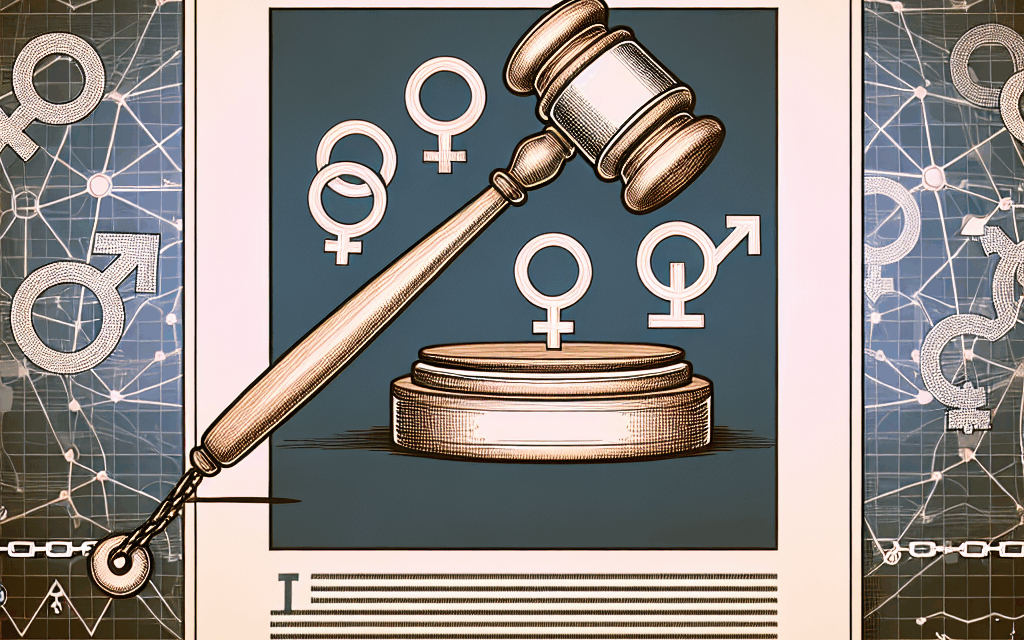Court Mandates HHS to Reinstate Gender Ideology Webpages
The recent court ruling mandating the U.S. Department of Health and Human Services (HHS) to reinstate gender ideology webpages has sparked significant debate across various sectors of society. This article delves into the implications of this ruling, the background of the case, the arguments presented, and the broader societal context surrounding gender identity and health policy. By examining these facets, we aim to provide a comprehensive understanding of the issue at hand.
Background of the Case
The legal battle surrounding the HHS’s gender ideology webpages began when the Trump administration removed several resources that provided information on gender identity and LGBTQ+ health issues. These resources were designed to educate the public and healthcare providers about the needs and rights of transgender and non-binary individuals. The removal of these pages was met with widespread criticism from advocacy groups, healthcare professionals, and members of the LGBTQ+ community.
In 2021, a coalition of advocacy organizations filed a lawsuit against the HHS, arguing that the removal of these resources violated the Administrative Procedure Act (APA) and constituted discrimination against transgender individuals. The plaintiffs contended that the absence of these resources hindered access to essential healthcare information and perpetuated stigma against gender-diverse populations.
After a lengthy legal process, the court ruled in favor of the plaintiffs, stating that the HHS’s actions were arbitrary and capricious. The ruling mandated the reinstatement of the gender ideology webpages, emphasizing the importance of providing accurate and accessible information regarding gender identity and health.
The Importance of Gender Ideology Webpages
The reinstatement of gender ideology webpages is crucial for several reasons, particularly in the context of public health and education. These resources serve as a vital tool for both individuals seeking information about gender identity and healthcare providers aiming to deliver inclusive and informed care.
- Access to Information: The webpages provide essential information about gender identity, including definitions, terminology, and resources for individuals exploring their gender. This access is particularly important for young people who may be questioning their identity.
- Healthcare Provider Education: The resources educate healthcare providers about the unique health needs of transgender and non-binary individuals, promoting culturally competent care. This education can lead to better health outcomes and reduced health disparities.
- Reducing Stigma: By providing accurate information about gender identity, these webpages help combat misinformation and stigma surrounding transgender individuals. This can foster a more inclusive society and encourage acceptance.
- Policy Guidance: The resources can inform policymakers about the needs of gender-diverse populations, guiding the development of inclusive health policies and practices.
- Community Support: The webpages often include links to support organizations and resources, helping individuals connect with community support networks.
In summary, the reinstatement of these webpages is not merely a matter of restoring lost information; it is about ensuring that individuals and healthcare providers have the tools they need to navigate the complexities of gender identity and health.
Arguments for and Against the Ruling
The court’s decision to mandate the reinstatement of gender ideology webpages has elicited a range of responses from various stakeholders. Supporters of the ruling argue that it is a necessary step toward ensuring equitable access to healthcare information for all individuals, regardless of their gender identity. Conversely, opponents contend that the reinstatement of these resources may promote ideologies they believe are harmful or misleading.
Supporters’ Arguments
Advocates for the reinstatement of the webpages emphasize several key points:
- Public Health Necessity: Supporters argue that access to accurate information about gender identity is essential for public health. Transgender individuals face significant health disparities, and providing resources can help address these issues.
- Legal Precedent: The ruling reinforces the principle that government agencies must provide accurate and comprehensive information to the public. This sets a precedent for future cases involving access to information.
- Empowerment: By reinstating these resources, the court empowers individuals to make informed decisions about their health and well-being, fostering autonomy and self-advocacy.
- Support for Vulnerable Populations: The ruling is seen as a victory for marginalized communities, particularly transgender youth who may be seeking guidance and support.
Opponents’ Arguments
On the other hand, opponents of the ruling present their concerns:
- Ideological Concerns: Some argue that the information presented on these webpages promotes a specific ideological perspective on gender that they believe is not scientifically supported.
- Parental Rights: Opponents often express concerns about parental rights, arguing that children should not be exposed to discussions about gender identity without parental consent.
- Potential for Misinformation: Critics contend that the information provided may lead to confusion or misinformation about gender identity, particularly among young people.
- Resource Allocation: Some argue that government resources should be allocated to other pressing health issues rather than focusing on gender identity.
The debate surrounding the ruling highlights the complexities of navigating issues of gender identity, public health, and individual rights. As society continues to grapple with these topics, it is essential to consider the diverse perspectives and experiences of all stakeholders involved.
Impact on Healthcare Policy
The reinstatement of gender ideology webpages is likely to have significant implications for healthcare policy in the United States. As healthcare systems increasingly recognize the importance of providing inclusive care, the availability of accurate information about gender identity will play a crucial role in shaping policies and practices.
Informed Policy Development
With the reinstatement of these resources, policymakers will have access to comprehensive information about the needs of transgender and non-binary individuals. This can inform the development of policies that promote equitable access to healthcare services. For example:
- Insurance Coverage: Policymakers can use the information to advocate for insurance coverage of gender-affirming treatments, such as hormone therapy and surgeries.
- Training Programs: The resources can guide the creation of training programs for healthcare providers, ensuring they are equipped to deliver culturally competent care.
- Data Collection: Policymakers can implement data collection practices that include gender identity, allowing for a better understanding of health disparities within the transgender community.
Addressing Health Disparities
The reinstatement of gender ideology webpages can also contribute to addressing health disparities faced by transgender individuals. Research has shown that transgender people experience higher rates of mental health issues, substance abuse, and chronic health conditions compared to their cisgender counterparts. By providing accurate information and resources, healthcare systems can work to mitigate these disparities.
For instance, healthcare providers can be better equipped to recognize and address the unique health needs of transgender patients, leading to improved health outcomes. Additionally, public health campaigns can be developed to raise awareness about the importance of inclusive care and the specific health challenges faced by gender-diverse populations.
Societal Reactions and Cultural Shifts
The court’s ruling has not only legal implications but also cultural ones. The reinstatement of gender ideology webpages reflects a broader societal shift toward recognizing and affirming diverse gender identities. This shift is evident in various aspects of culture, including media representation, education, and public discourse.
Media Representation
In recent years, there has been a noticeable increase in the representation of transgender and non-binary individuals in media. Television shows, films, and social media platforms have begun to feature more diverse narratives that challenge traditional notions of gender. This representation plays a crucial role in shaping public perceptions and fostering acceptance.
For example, popular television series like “Pose” and “Euphoria” have brought transgender stories to the forefront, highlighting the experiences and challenges faced by gender-diverse individuals. Such representation can help normalize discussions about gender identity and promote understanding among audiences.
Educational Initiatives
Educational institutions are also beginning to incorporate discussions about gender identity into their curricula. Schools are increasingly recognizing the importance of creating inclusive environments for all students, regardless of their gender identity. This includes implementing anti-bullying policies, providing training for educators, and offering resources for students and families.
For instance, some school districts have adopted comprehensive sex education programs that include discussions about gender identity and expression. These initiatives aim to foster a more inclusive and supportive environment for all students, helping to reduce stigma and promote acceptance.
Public Discourse
The ruling has also sparked conversations about gender identity in public discourse. Social media platforms have become spaces for individuals to share their experiences and advocate for their rights. Hashtags like #TransRightsAreHumanRights have gained traction, amplifying the voices of transgender individuals and their allies.
As discussions about gender identity become more prevalent, it is essential for society to engage in respectful and informed conversations. This includes recognizing the diversity of experiences within the transgender community and understanding the intersectionality of gender identity with other social identities, such as race, class, and sexuality.
Conclusion
The court’s mandate for the HHS to reinstate gender ideology webpages marks a significant moment in the ongoing struggle for transgender rights and healthcare access. By providing essential information and resources, these webpages play a crucial role in promoting understanding, acceptance, and equitable healthcare for gender-diverse individuals.
As society continues to navigate the complexities of gender identity, it is vital to recognize the importance of informed discussions and inclusive policies. The reinstatement of these resources not only empowers individuals but also sets a precedent for future legal and policy developments in the realm of gender identity and health.
In summary, the ruling underscores the necessity of providing accurate information about gender identity, addressing health disparities, and fostering a culture of acceptance. As we move forward, it is essential to continue advocating for the rights and needs of all individuals, ensuring that everyone has access to the resources and support they deserve.





